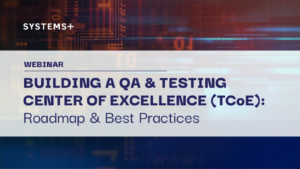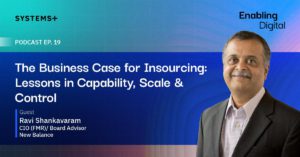Posted : June 12th, 2023
The role of the Chief Information Officer (CIO) has become increasingly vital. The ever-evolving business landscape, technological disruptions, and intensifying competition have elevated the significance of effective IT leadership.
In 2023, we observe a noteworthy shift in priorities for CIOs, particularly with a strong focus on the perspective of Global In-house Centres (GICs). These centers of excellence, established by companies to support their global operations, are gaining prominence in the strategies of organizations worldwide. As a result, the role of CIOs and IT leaders becomes even more crucial in steering organizations through crises and empowering them to emerge stronger on the other side.
This blog explores the key priorities, challenges, strategies, and solutions that IT leaders can undertake in prioritizing business continuity and resilience. We also uncover the innovative approaches CIOs can employ to navigate uncertainties, harness emerging technologies, and drive sustainable growth.
Talent Management
With the growing demand for IT talent, talent management remains one of the top priorities for CIOs in 2023. IT leaders are looking for innovative ways to attract and retain top talent. GICs play a crucial role in talent management as they are responsible for building and managing IT teams. CIOs are investing in employee training programs, flexible work arrangements, and other employee benefits to retain top talent as organizations seek to attract and develop top talent in a competitive global marketplace. With a robust talent management strategy in place, CIOs can proactively identify skill gaps, develop comprehensive training programs, and attract top talent from the competitive market Here are the pros and cons of talent management, along with the goals, challenges, and solutions.
Pros:
- Improved productivity: Effective talent management practices can help improve employee productivity and performance.
- Competitive advantage: Attracting and retaining top talent can provide a competitive advantage in a crowded marketplace.
- Enhanced innovation: A diverse and talented workforce can bring fresh perspectives and innovative ideas to an organization.
Cons:
- High costs: Investing in talent management initiatives can be expensive, requiring significant investment in hiring, training, and development.
- Talent shortage: There is a shortage of talent in many areas related to IT, such as cybersecurity and AI, making it difficult to attract and retain top talent.
- Resistance to change: Employees may resist changes to talent management practices, leading to slow adoption and implementation.
Goals:
- Attract and retain top talent: Effective talent management practices can help attract and retain top talent, ensuring that organizations have the right people in the right roles.
- Develop and train employees: Investing in employee development and training can help improve employee performance and productivity.
- Foster a diverse and inclusive workplace: A diverse and inclusive workplace can enhance innovation and provide a competitive advantage.
Challenges:
- Talent acquisition: Attracting top talent can be a challenge, especially in areas with high competition and talent shortages.
- Retention: Retaining top talent can be a challenge, especially when employees are offered more attractive opportunities elsewhere.
- Skills gap: There may be a gap between the skills that employees have and the skills that organizations need, requiring investment in training and development.
Solutions:
- Employer branding: Building a strong employer brand can help attract top talent and differentiate an organization from competitors.
- Talent development: Investing in employee development and training can help bridge the skills gap and improve employee performance.
- Flexibility: Offering flexible work arrangements, such as remote work, can help attract and retain top talent.
In conclusion, talent management is a critical priority for organizations in 2023 due to its profound impact on driving innovation and aligning technological capabilities with strategic goals. Achieving the goals of talent management requires addressing the challenges associated with talent acquisition, retention, and skills gaps. Building a strong employer brand, investing in talent development, and offering flexible work arrangements can help organizations attract and retain top talent and gain a competitive advantage.
Digital Transformation
Digital transformation is a key priority for CIOs in 2023. IT leaders are leveraging digital technologies to streamline business processes and enhance customer experience. GICs play a critical role in digital transformation as they support global operations and facilitate collaboration between teams. CIOs are investing in cloud computing, automation, and IoT to drive digital transformation. Digital transformation is a key priority for IT leaders in 2023, as organizations look to leverage digital technologies to streamline business processes and enhance customer experience. Here are the pros and cons of digital transformation, along with the goals, challenges, and solutions.
Pros:
- Improved efficiency: Digital transformation can streamline business processes, automate repetitive tasks, and improve overall efficiency.
- Enhanced customer experience: By leveraging digital technologies, organizations can provide a better customer experience, leading to increased customer satisfaction and loyalty.
- Increased agility: Digital transformation enables organizations to adapt to changing market conditions and respond to customer needs more quickly.
Cons:
- Implementation costs: Implementing digital transformation initiatives can be costly, requiring significant investment in hardware, software, and talent.
- Resistance to change: Employees may resist change and be hesitant to adopt new technologies, slowing down the implementation process.
- Cybersecurity risks: Digital transformation initiatives may create new cybersecurity risks that need to be addressed.
Goals:
- Streamline processes: Digital transformation can streamline processes, making them more efficient and cost-effective.
- Improve customer experience: By leveraging digital technologies, organizations can provide a better customer experience, improving customer satisfaction and loyalty.
- Increase agility: Digital transformation can make organizations more agile, enabling them to respond more quickly to changing market conditions and customer needs.
Challenges:
- Legacy systems: Many organizations have legacy systems that are outdated and incompatible with new technologies, making it difficult to implement digital transformation initiatives.
- Talent shortage: There is a shortage of talent in many areas related to digital transformation, such as data analytics and AI.
- Integration challenges: Integrating new digital technologies with existing systems can be complex and challenging.
Solutions:
- Start small: Organizations can start with small digital transformation initiatives to test the waters and gain buy-in from employees.
- Talent development: Investing in talent development programs can help address the talent shortage and ensure that employees have the necessary skills to implement digital transformation initiatives.
- Collaborative approach: Taking a collaborative approach to digital transformation, involving stakeholders from across the organization, can help ensure that initiatives are successful and address the needs of all departments.
In summary, digital transformation stands as a critical imperative for organizations in 2023. To achieve digital transformation goals, addressing challenges related to legacy systems, talent shortages, and integration is vital. By adopting a collaborative approach and making strategic investments in talent development, organizations can ensure the success of their digital transformation initiatives. This proactive approach will pave the way for navigating complexities, unlocking new opportunities, and establishing a position of leadership in the digital landscape.
Innovation
Innovation is a top priority for CIOs in 2023. IT leaders are looking for innovative ways to improve business processes, enhance customer experience, and drive growth. GICs play a crucial role in innovation as they are responsible for driving new initiatives and developing new technologies. CIOs are investing in innovation labs and centers of excellence to foster a culture of innovation within their organizations as they seek to stay ahead of the competition by developing new products, services, and technologies. Here are the pros and cons of innovation, along with the trends, goals, challenges, and solutions.
Pros:
- Competitive advantage: Innovation can provide a competitive advantage by enabling organizations to offer unique products, services, and technologies.
- Increased revenue: Innovation can lead to the development of new revenue streams, as well as the expansion of existing ones.
- Improved customer satisfaction: Innovation can help organizations meet customer needs and expectations, leading to improved satisfaction and loyalty.
Cons:
- Cost: Innovation initiatives can be expensive, requiring investment in research and development, talent, and infrastructure.
- Risk: Innovation initiatives come with a degree of risk, as there is no guarantee that new products, services, or technologies will be successful.
- Time-consuming: Innovation initiatives can be time-consuming, requiring significant investment in planning, development, and testing.
Trends:
- Open innovation: Open innovation involves collaborating with external partners, such as customers, suppliers, and academic institutions, to develop new ideas and technologies.
- Digital innovation: Digital innovation involves leveraging digital technologies, such as artificial intelligence and the Internet of Things, to develop new products and services.
- Sustainability innovation: Sustainability innovation involves developing environmentally friendly products and services that are socially responsible and meet the needs of consumers.
Goals:
- Develop new products and services: The goal of innovation is to develop new products and services that meet customer needs and expectations.
- Improve business processes: Innovation can help organizations improve their business processes, leading to increased efficiency and productivity.
- Expand revenue streams: Innovation can lead to the development of new revenue streams and the expansion of existing ones.
Challenges:
- Lack of resources: Innovation initiatives require significant resource investment, including talent, technology, and infrastructure.
- Risk management: Innovation initiatives come with a degree of risk, and organizations must manage that risk to ensure that they are making informed decisions.
- Resistance to change: Innovation initiatives can be met with resistance from employees who are comfortable with the status quo.
Solutions:
- Invest in talent: Organizations should invest in talent development programs to build the skills and expertise needed for innovation initiatives.
- Create a culture of innovation: Organizations should promote a culture of innovation, where employees are encouraged to generate new ideas and take risks.
- Collaborate with external partners: Organizations can collaborate with external partners, such as academic institutions and technology vendors, to build talent and expertise in innovation.
In conclusion, innovation is a critical priority for organizations in 2023, but it comes with its pros and cons. Achieving the goals of innovation requires addressing the challenges associated with resources, risk management, and resistance to change. Implementing best practices for talent development, promoting a culture of innovation, and collaborating with external partners can help organizations make the most of their innovation initiatives and gain a competitive advantage.
Strategic Advantages of Establishing a Global In-house Center
Global In-house Centers (GICs) play a pivotal role in talent management, driving digital transformation, and fostering innovation within organizations. Here’s how GICs contribute to these crucial aspects:
- Talent Management: GICs serve as talent hubs, attracting skilled professionals and nurturing their development. They provide opportunities for employees to work on challenging projects, gain diverse experiences, and expand their skill sets. Through talent management initiatives such as training programs, mentorship, and career progression paths, GICs create a supportive environment that fosters continuous learning and growth. By attracting and retaining top talent, GICs contribute to building a strong technology workforce, crucial for driving digital transformation.
- Digital Transformation: GICs act as catalysts for digital transformation within organizations. With their specialized knowledge and expertise, GICs actively contribute to the adoption and implementation of digital technologies. They serve as centers of excellence, enabling the organization to leverage emerging technologies such as artificial intelligence, machine learning, data analytics, and automation. GICs collaborate closely with business units to identify digital transformation opportunities, develop innovative solutions, and drive the integration of digital technologies into various aspects of the organization’s operations.
- Driving Innovation: GICs are hubs of innovation, facilitating collaboration and ideation. They provide an environment that encourages creativity and the exploration of new ideas. GICs leverage their deep industry knowledge, market insights, and cross-functional expertise to drive innovation initiatives. By fostering a culture of innovation, GICs enable employees to think outside the box, experiment with new technologies, and develop groundbreaking solutions. GICs also play a vital role in collaborating with external partners, startups, and academia to access cutting-edge innovations and stay at the forefront of technological advancements.
In summary, GICs contribute significantly to talent management by attracting and developing skilled professionals. They drive digital transformation by leveraging their expertise in emerging technologies and collaborating with business units. Moreover, GICs foster innovation through a culture of creativity and collaboration, enabling organizations to stay competitive and embrace new opportunities. With their multifaceted contributions, GICs serve as key enablers for organizations aiming to excel in talent management, drive digital transformation, and foster a culture of innovation.
Experience the Power of Managed GIC Solutions with Systems Plus
GCC (Global Capability Center) can be a complex endeavor, but when approached strategically, it offers tremendous benefits. The key to unlocking cost savings and streamlining operations lies in partnering with experts. By adopting a Managed GCC (Virtual Captive) model, organizations can mitigate risks while maximizing advantages.
At Systems Plus, we have a proven track record of delivering Managed GCC solutions (also known as Virtual Captives) to our clients for over a decade. Our Virtual Captive model eliminates the challenges associated with traditional outsourcing, making it the optimal choice for enterprises of all sizes.
Contact us today for a consultation and discover your organization’s true potential to empower the digital transformation journey with Systems Plus.







